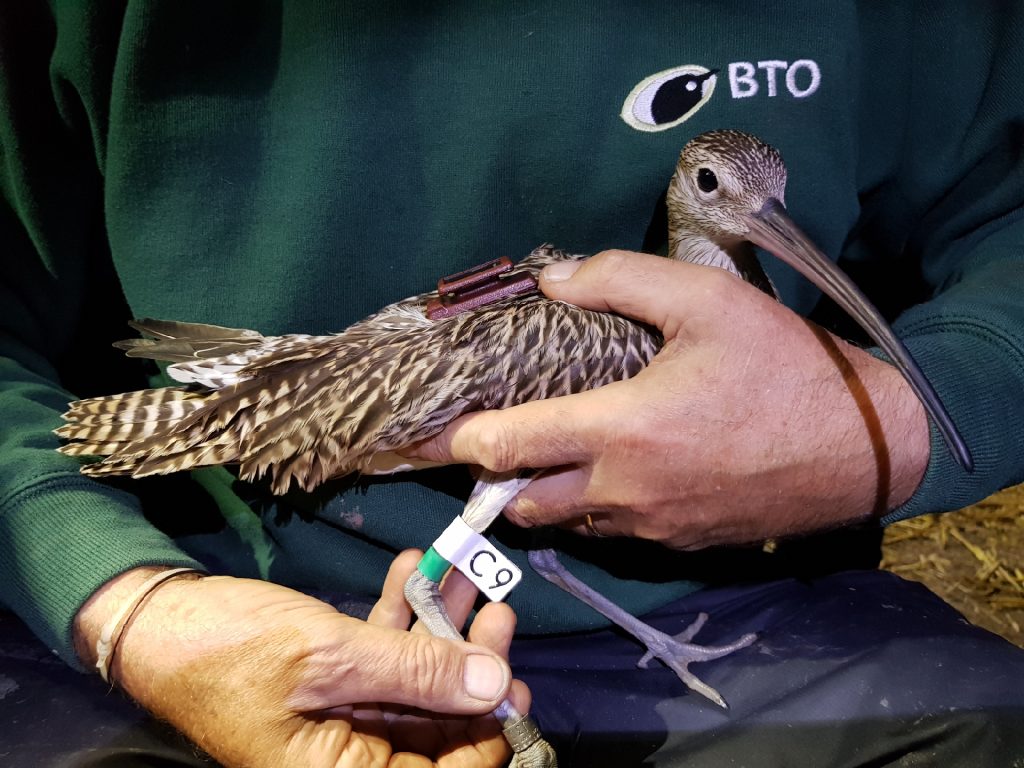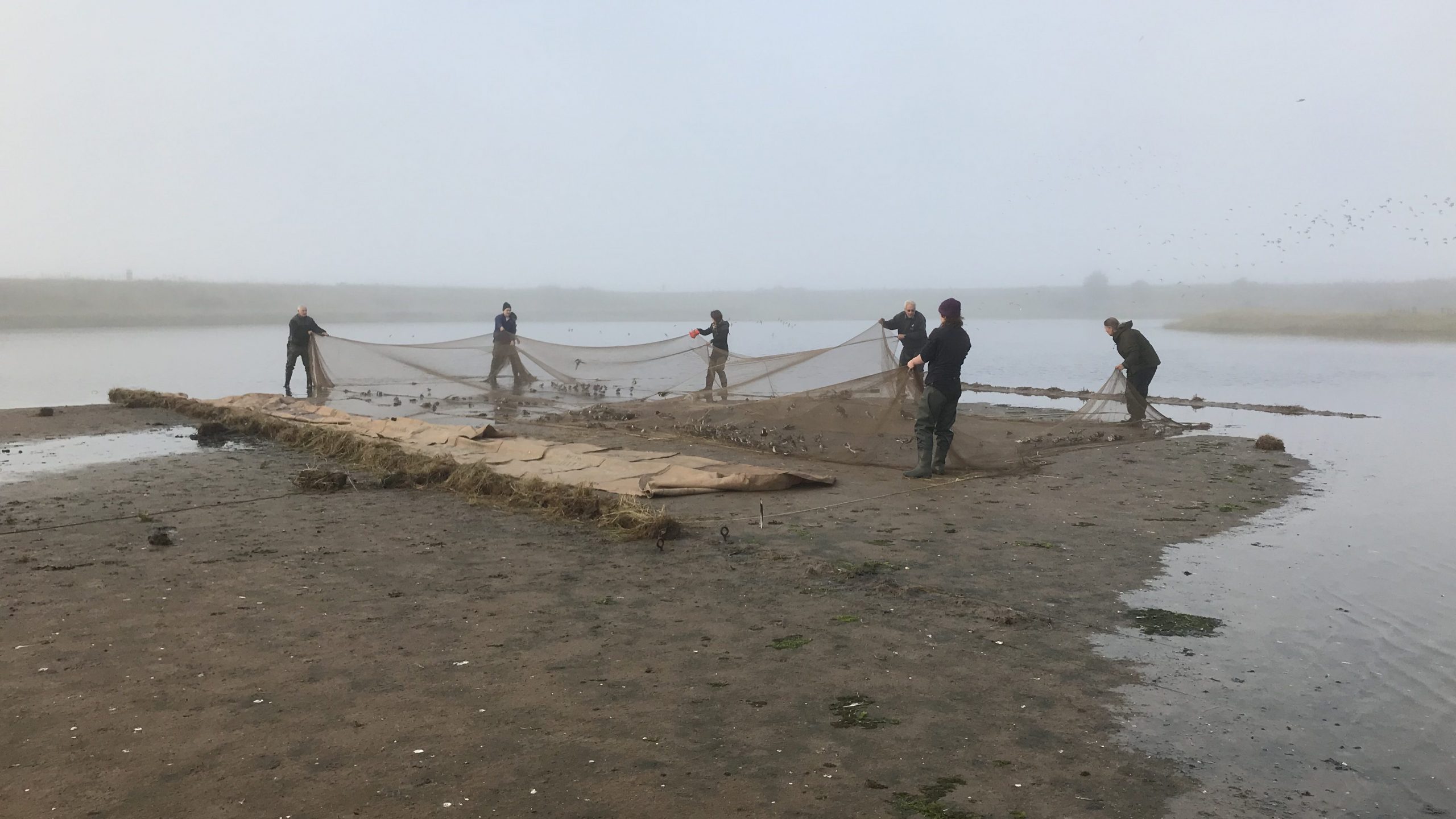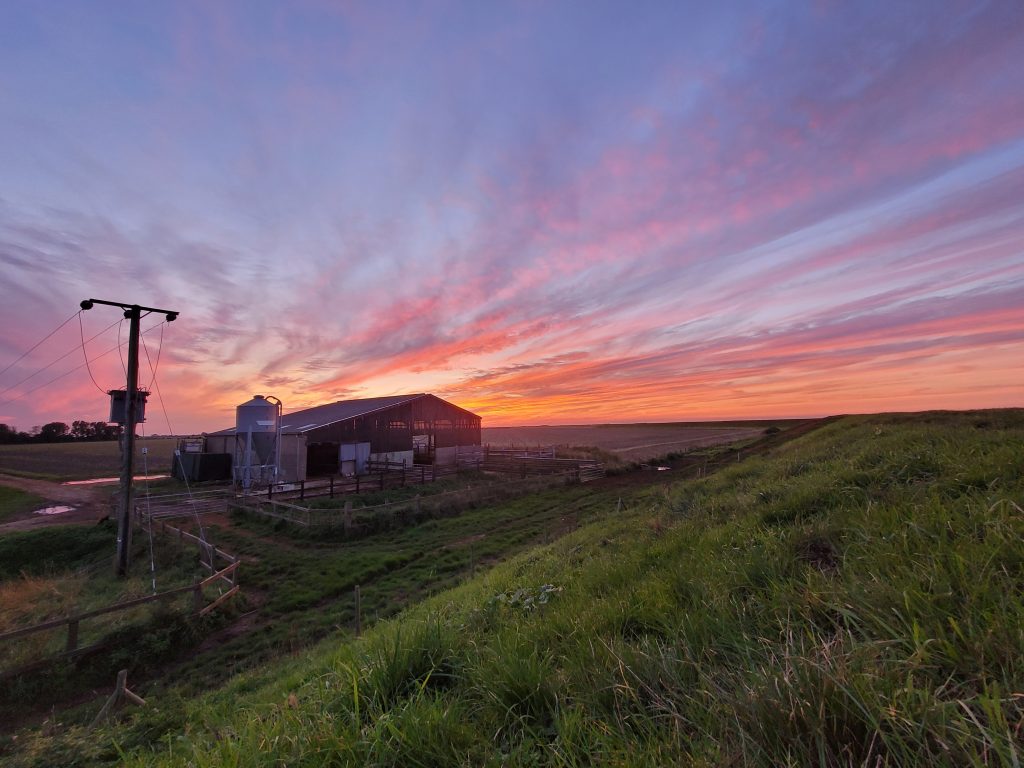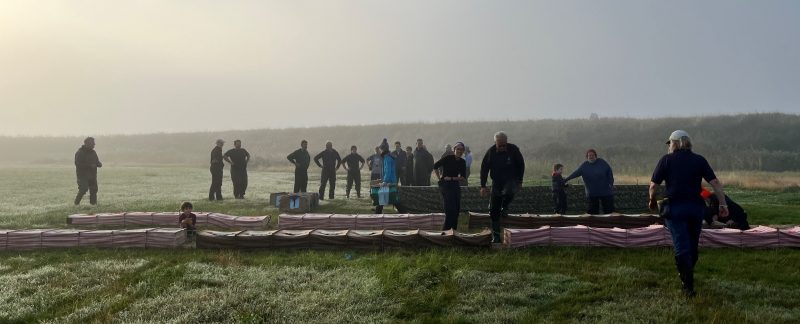Friday 9 September
The first members of the trip arrived at the Norfolk base on Friday.
Tim went out to recce on the evening tide at the White Barn. On a new pool out from the traditional White Barn catching pool there were 300 Redshank and 250 Dunlin.
Saturday 10 September
Norfolk:
Nigel and Tim went out in the afternoon to check out the new pool that Tim had found on Friday. They decided to set a single net there with a team of seven in a hide and a second team hiding out on the marsh. Bamboo poles were used to support the hide as they were lighter to carry further out onto the marsh to the new pool. The second team couldn’t see from where they were hiding in the long grass but they did enjoy a lovely sunset. The hide team was able to get to the net very quickly, the second team made a good effort to run the longer distance to the net.
The decision to fire on a small number of birds was taken as the Curlew looked to be juveniles and we were keen to deploy GPS/GSM tags on more juveniles to compare their movements to both the adults and the head-started juveniles. The Curlew were indeed juveniles and both birds were fitted with a tag. Most of the team stayed to observe the Curlew tagging and to process the Grey Plover and Dunlin. Some of the Lincolnshire team headed straight round to Friskney Village Hall after the catch to get a little bit more sleep for the first night.
| Species | New | Retrap | Total |
| Grey Plover | 1 | – | 1 |
| Dunlin | 1 | – | 1 |
| Curlew | 2 | – | 2 |
| Totals | 4 | – | 4 |

Lincolnshire:
Steve and Will set a new three-cannon net on the central island spit of the Horseshoe Lagoon in the afternoon after a successful recce from Steve.
Sunday 11 September
Norfolk:
Ryan headed to Snettisham and the fields near Wolferton to recce on the morning tide. Unfortunately, there was thick fog so visibility was extremely poor; however, the fog lifted enough for Ryan to see over 100 Sanderling at Snettisham and 200 Curlew in a single field. David recced Terrington and experienced the same conditions.
Lincolnshire:
Most of the Lincolnshire team headed to the Horseshoe before sunrise with five under the tarp on the island and Steve in position to watch the net from the seawall. Unfortunately, thick fog had rolled in overnight and meant that Steve was not able to see the set, markers or birds. Frustratingly, the team could hear birds coming into the lagoon but still couldn’t see them.
After a while there was a brief respite in the fog and Steve was able to briefly see Bar-tailed Godwits and the markers. The rest of the Lincolnshire team and the Norfolk team arrived at the site at 06:35 and remained hidden in vehicles. There was some brief discussion on the radio between Steve and Nigel, what was visible (or not!) and how long to risk waiting until better visibility. Steve had moved closer on the sea wall to the set to try to get a better view. Eventually, the fog lifted enough for Steve to fire, much to the surprise to the team under the tarp who were mid-conversation waiting for an update.
Throughout processing the HPAI protocols were implemented and adapted as the morning went on, with kit disinfecting, reducing the mixing of birds and regular hand sanitising.
| Species | New | Retrap | Total |
| Oystercatcher | 8 | 2 | 10 |
| Grey Plover | 26 | 1 | 27 |
| Knot | 40 | 2 | 42 |
| Dunlin | 219 | 3 | 222 |
| Bar-tailed Godwit | 3 | – | 3 |
| Totals | 296 | 8 | 304 |

Alex, Molly and Will headed back to Friskney Village Hall ahead of the rest of the team to get a start on breakfast. Despite ‘guesstimating’ the team size and proportions required, enough food was made and no one went hungry.
Breakfast was followed by a debrief of the Horseshoe catch and a briefing for the next 24 hours. Trailer kit was sorted, the Norfolk team headed over to set at Gedney and the Lincolnshire team packed up enough personal kit to relocate to the Norfolk base for the night.
Norfolk:
The Norfolk team went out on the marsh and had set at Gedney by 16:00, just in time for the food arriving fresh from the Boston ASDA. A picnic-style dinner was had by all behind the sea wall before a team of six headed out at 16:40 to hide under a tarp close to the net set. The rest of the team formed a base camp near to the sea wall and were in position by 17:15.
A very slow start, but eventually a handful of birds landed on the pool in front of the net, but the birds were disturbed by two very low flying paramotorists. Eventually some of the birds returned to the pool and Richard counted down and fired at 18:55. A smaller catch but ‘team poop’ were able to collect their first samples of the week.
| Species | New | Retrap | Total |
| Grey Plover | 4 | – | 4 |
| Knot | 2 | – | 2 |
| Dunlin | 6 | – | 6 |
| Black-tailed Godwit | 1 | – | 1 |
| Redshank | 26 | 4 | 30 |
| Totals | 39 | 4 | 43 |
Monday 12 September
Lincolnshire:
Will went to recce at Freiston Shore on the morning tide and had seven flagged Redshank amongst a flock of around 700. Moving north, there were 200 Curlew scattered around the northern end of the field by the Southern Pumping Station on the outer reclaim. Further on, there were 50 Curlew with 250 mixed gulls at the north end of the most northerly field on the outer reclaim, adjacent to the Northern Pumping Station, with a further 120 Curlew on the saltings just to the north of the sea wall. Later on, there were 350 Oystercatchers at the Horseshoe Lagoon with a small number of Dunlin and Redshank, all of which were disturbed by dog walkers at 09:00 and didn’t return. The fields to the north of the Horseshoe were checked but were empty of birds.
Norfolk:
The setting team headed off to Snettisham at 05:00, with base camp leaving at 06:00. At 07:00 there were around 300 birds on the beach but not quite in front of the net set. Cathy started to twinkle from the north and Alex, positioned as long stop to the south, worked on twinkling anything that was on the remaining beach towards Heacham. Eventually, twinkling and jiggling paid off and a good catch was taken. Following HPAI protocols went smoothly with our experience from the previous day. Anna and Keeley (a.k.a. ‘team poop’) managed to get samples from 42 Sanderling.
| Species | New | Retrap | Total |
| Oystercatcher | 19 | – | 19 |
| Knot | 1 | – | 1 |
| Ringed Plover | – | 1 | 1 |
| Sanderling | 182 | 31 | 213 |
| Dunlin | 13 | – | 13 |
| Totals | 215 | 32 | 247 |
After the catch, the Norfolk team headed to a field near Wolferton to set cannon nets for tomorrow where Curlew had been seen landing at 08:07. The hope is for around 30 Curlew and there were six GPS/GSM tags to be deployed.
At around 19:00, there was a hunt for radios at the base house. Eventually we realised that Sam had accidentally taken them home with her so Michelle and Ryan offered to go and meet David part way and pick them up. Michelle had just started reversing when a loud bang was heard! The car had just clipped the pavement in from of the front door and punctured the tyre. Thankfully Ryan took over driving duties, drove the radio retrieval mission in his car and successfully retrieved them.
The Lincolnshire team headed back to the Norfolk base for breakfast and then round to Lincolnshire to also set nets to target Curlew in the morning. Alex, with the help of her sous chefs, made a pasta bake that was enormous even by WWRG standards, especially when there were only eight members of the team by that point! Molly made an apple crumble for pudding using some of the apples harvested from Jacquie and Nigel’s trees.
Both teams had a free evening due to rain.
Tuesday 13 September
Norfolk, field near Wolferton:
There were five vehicles in position just after 08:30 ready and waiting to drive closer to the set at time of fire. 600–800 Curlew were in the surrounding area, with some birds coming down to the catching site and then lifting off again. Two paramotorists flew close to the net set field and disturbed the birds yet again. Eventually, about 500 Curlew came on to the filed between the hide and the nets, but were very jumpy. With no easy way of moving birds into the catching area, Nigel decided to fire on 10 Curlew so that we could put the tags on.
Once the cannons were fired, all of the vehicles drove towards the catching area before the team disembarked and, working quietly, extracted the birds and prepared boxes and keeping cages. All six Curlew tags were successfully deployed and the team was packing up by 11:00. The catch was smaller than expected as the nets didn’t go out very well, possibly because we were cautious with the new powder, which is faster burning, and not enough was put into the cartridges. In theory, jiggling would have been a good move before the catch but as the birds were so unsettled, Nigel decided to settle for a smaller catch.
| Species | New | Retrap | Total |
| Bar-tailed Godwit | 3 | – | 3 |
| Curlew | 8 | 1 | 9 |
| Totals | 11 | 1 | 12 |
Lincolnshire, Benington:
A line of two cannon nets were set on a freshly drilled field – the team were very careful to only use one narrow line of footprints to get to and from the set. A few birds came into the area surrounding the nets but no great numbers. Will sprinted across the field to the north to intercept a dog walker who was making their way along the sea wall towards the set. After a while, Tim drove round to the opposite end of the catching field and slowly did some vehicle twinkling. Unfortunately, a birder and another dog walker caused the birds to lift. Most flocks of Curlew flying in the area were not looking interested in stopping in the fields around the nets. Rob and Alex drove north to see if there were any Curlew in fields that could be twinkled. Eventually, with high tide nearing, we took a small catch of Curlew.
| Species | New | Retrap | Total |
| Curlew | 2 | – | 2 |
| Totals | 2 | – | 2 |
Molly went to recce at the Horseshoe Lagoon. On the nearside around the usual catching site there was a maximum of 150 Oystercatchers, 70 Dunlin, 60 Redshank, 20 Bar-tailed Godwit and 15 Grey Plover. There were also quite a few gulls standing on the mud walls as well as being well spread out amongst the samphire. On the other side of the lagoon where the inlet pipe is, there was a building number of Redshank which reached around 250 along with 40 Dunlin and 20 Bar-tailed Godwit. This flock began to reduce as the lagoon filled.
Norfolk, Terrington mist netting:
An excellent mist-net catch with nets on the usual White Barn pool and on the new pool further out on the marsh. The team headed out to the marsh at 19:30. Both net lines caught well and the nets were taken down before high tide as we had such a good catch.
| Species | New | Retrap | Total |
| Grey Plover | 1 | – | 1 |
| Knot | 1 | – | 1 |
| Dunlin | 13 | – | 13 |
| Black-tailed Godwit | 4 | – | 4 |
| Bar-tailed Godwit | 3 | – | 3 |
| Curlew | 2 | – | 2 |
| Redshank | 114 | 2 | 116 |
| Turnstone | 2 | – | 2 |
| Totals | 140 | 2 | 142 |

Lincolnshire, Friskney mist netting:
A swift net set after dinner in an E formation. The team enjoyed a colourful sunset over the fields before heading out to put the sound lure on and start net rounds.
| Species | New | Retrap | Total |
| Grey Plover | 1 | – | 1 |
| Knot | 6 | – | 6 |
| Dunlin | 27 | 2 | 29 |
| Bar-tailed Godwit | 16 | 1 | 17 |
| Curlew | 1 | – | 1 |
| Redshank | 29 | 1 | 30 |
| Totals | 80 | 4 | 84 |
Wednesday 14 September
Lincolnshire, Horseshoe Lagoon:
The team had swiftly set the three-cannon net on the small spit near the inflow pipe by 07:00. They then split between hiding under the tarp at the base of the seawall and the hide. The birds were nicely building up to around 90. A bit of jiggling was undertaken and Steve debated taking a catch. Unfortunately, the birds lifted not long after, potentially due to a raptor or Steve’s voice carrying from the hide. 50 birds then returned to the catching area but a dog walker came along the sea wall and caused the birds to lift again. A few of the Norfolk team had travelled around to the Horseshoe for the catch and arrived on site at 08:45. As the lagoon doesn’t reach full water height until after high tide, Steve held on waiting to see if more birds would return. With only one Greenshank 10 yards out from the net (and with the tarp team suffering in the heat), the catch was abandoned at 10:04.
Norfolk:
The rest of the Norfolk team either went resighting or worked on paperwork.
Norfolk, Terrington – mist netting:
A team of eight set all 15 nets on the new, outer pool only. Everyone was on site by 19:30. The first team headed out to put the sound lure on at 20:00. The second team headed onto the marsh at 20:15. Everything ringed and processed by 02:15.
| Species | New | Retrap | Total |
| Oystercatcher | 1 | – | 1 |
| Grey Plover | 5 | – | 5 |
| Knot | 7 | – | 7 |
| Dunlin | 23 | – | 23 |
| Black-tailed Godwit | 4 | – | 4 |
| Bar-tailed Godwit | 3 | – | 3 |
| Curlew | 4 | – | 4 |
| Redshank | 117 | 7 | 124 |
| Turnstone | 11 | 1 | 12 |
| Totals | 176 | 8 | 184 |
Lincolnshire, Leverton (Bowser’s) – mist netting:
The team navigated their way out to the catching pool and set an E-shape formation before heading back to basecamp just as Will was driving up the track with the fish and chips. A successful catching night, especially considering the deciding factor in choosing to mist net at Bowser’s tonight was to try to catch and colour mark a good number of Redshank in the vicinity of Freiston.
| Species | New | Retrap | Total |
| Grey Plover | 2 | – | 2 |
| Knot | 3 | – | 3 |
| Curlew Sandpiper | 1 | – | 1 |
| Dunlin | 72 | 2 | 74 |
| Black-tailed Godwit | 1 | – | 1 |
| Bar-tailed Godwit | 8 | – | 8 |
| Whimbrel | 1 | – | 1 |
| Curlew | 5 | – | 5 |
| Redshank | 73 | – | 73 |
| Turnstone | 1 | – | 1 |
| Totals | 167 | 2 | 169 |
Trip totals
Colour-mark Resighting Totals
| Species | Total Sightings | Individuals |
| Redshank | 25 | 17 |
| Turnstone | 6 | 6 |
| Bar-tailed Godwit | 6 | 6 |
| Curlew | 56 | 42 |
| Total | 96 | 72 |
Notes: Two head-started Curlew were seen in addition to the WWRG birds. A Mid-Wales Ringing Group Redshank was also seen.
Ringing totals
| Species | New | Retrap | Total |
| Oystercatcher | 10 | 2 | 12 |
| Ringed Plover | 19 | 1 | 20 |
| Grey Plover | 40 | 1 | 41 |
| Knot | 60 | 2 | 62 |
| Sanderling | 182 | 31 | 213 |
| Curlew Sandpiper | 1 | – | 1 |
| Dunlin | 374 | 7 | 381 |
| Black-tailed Godwit | 10 | – | 10 |
| Bar-tailed Godwit | 36 | 1 | 37 |
| Whimbrel | 1 | – | 1 |
| Curlew | 24 | 1 | 25 |
| Redshank | 359 | 14 | 373 |
| Turnstone | 14 | 1 | 15 |
| Total | 1,130 | 61 | 1,191 |
Thanks to Alex Dodds for writing this report.

